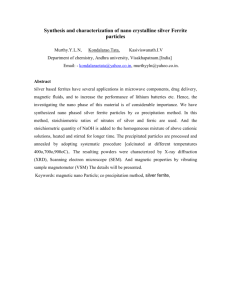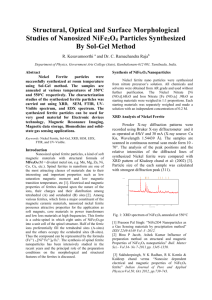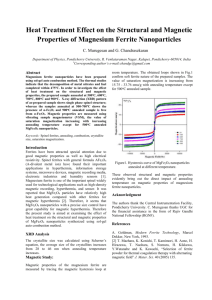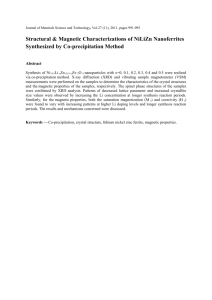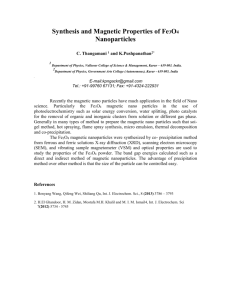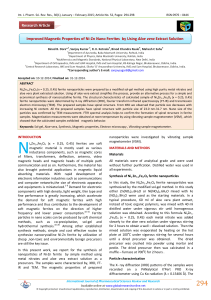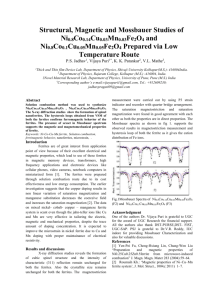Document 13310173
advertisement
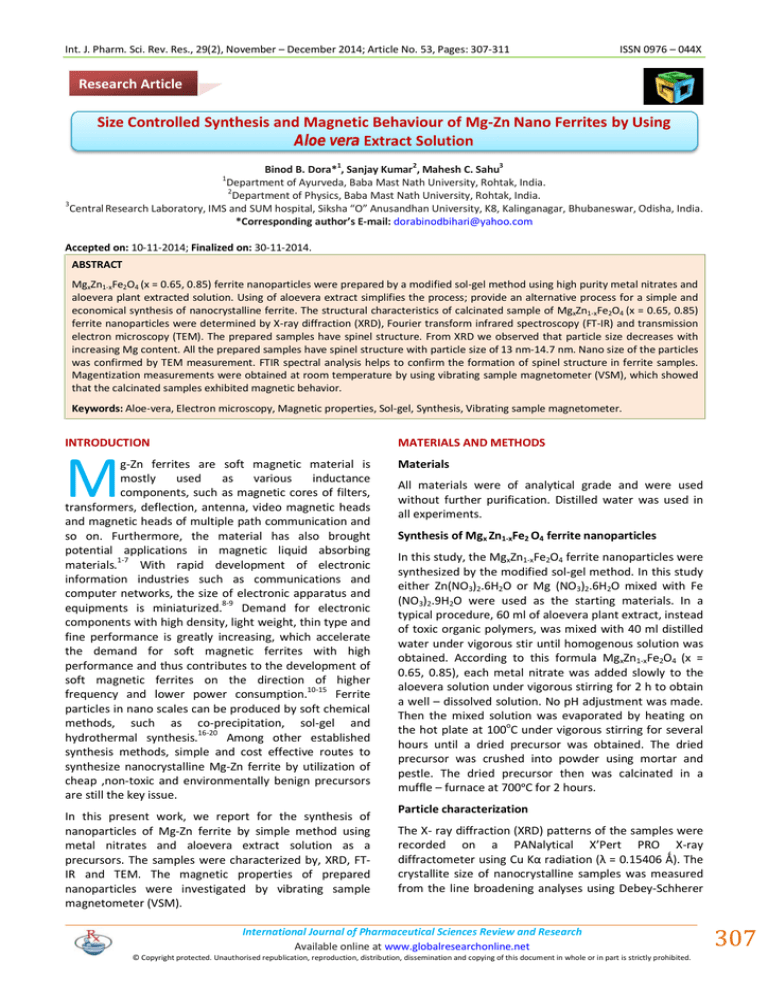
Int. J. Pharm. Sci. Rev. Res., 29(2), November – December 2014; Article No. 53, Pages: 307-311 ISSN 0976 – 044X Research Article Size Controlled Synthesis and Magnetic Behaviour of Mg-Zn Nano Ferrites by Using Aloe vera Extract Solution 1 2 3 Binod B. Dora* , Sanjay Kumar , Mahesh C. Sahu Department of Ayurveda, Baba Mast Nath University, Rohtak, India. 2 Department of Physics, Baba Mast Nath University, Rohtak, India. 3 Central Research Laboratory, IMS and SUM hospital, Siksha “O” Anusandhan University, K8, Kalinganagar, Bhubaneswar, Odisha, India. *Corresponding author’s E-mail: dorabinodbihari@yahoo.com 1 Accepted on: 10-11-2014; Finalized on: 30-11-2014. ABSTRACT MgxZn1-xFe2O4 (x = 0.65, 0.85) ferrite nanoparticles were prepared by a modified sol-gel method using high purity metal nitrates and aloevera plant extracted solution. Using of aloevera extract simplifies the process; provide an alternative process for a simple and economical synthesis of nanocrystalline ferrite. The structural characteristics of calcinated sample of MgxZn1-xFe2O4 (x = 0.65, 0.85) ferrite nanoparticles were determined by X-ray diffraction (XRD), Fourier transform infrared spectroscopy (FT-IR) and transmission electron microscopy (TEM). The prepared samples have spinel structure. From XRD we observed that particle size decreases with increasing Mg content. All the prepared samples have spinel structure with particle size of 13 nm-14.7 nm. Nano size of the particles was confirmed by TEM measurement. FTIR spectral analysis helps to confirm the formation of spinel structure in ferrite samples. Magentization measurements were obtained at room temperature by using vibrating sample magnetometer (VSM), which showed that the calcinated samples exhibited magnetic behavior. Keywords: Aloe-vera, Electron microscopy, Magnetic properties, Sol-gel, Synthesis, Vibrating sample magnetometer. INTRODUCTION MATERIALS AND METHODS M g-Zn ferrites are soft magnetic material is mostly used as various inductance components, such as magnetic cores of filters, transformers, deflection, antenna, video magnetic heads and magnetic heads of multiple path communication and so on. Furthermore, the material has also brought potential applications in magnetic liquid absorbing materials.1-7 With rapid development of electronic information industries such as communications and computer networks, the size of electronic apparatus and equipments is miniaturized.8-9 Demand for electronic components with high density, light weight, thin type and fine performance is greatly increasing, which accelerate the demand for soft magnetic ferrites with high performance and thus contributes to the development of soft magnetic ferrites on the direction of higher frequency and lower power consumption.10-15 Ferrite particles in nano scales can be produced by soft chemical methods, such as co-precipitation, sol-gel and hydrothermal synthesis.16-20 Among other established synthesis methods, simple and cost effective routes to synthesize nanocrystalline Mg-Zn ferrite by utilization of cheap ,non-toxic and environmentally benign precursors are still the key issue. In this present work, we report for the synthesis of nanoparticles of Mg-Zn ferrite by simple method using metal nitrates and aloevera extract solution as a precursors. The samples were characterized by, XRD, FTIR and TEM. The magnetic properties of prepared nanoparticles were investigated by vibrating sample magnetometer (VSM). Materials All materials were of analytical grade and were used without further purification. Distilled water was used in all experiments. Synthesis of Mgx Zn1-xFe2 O4 ferrite nanoparticles In this study, the MgxZn1-xFe2O4 ferrite nanoparticles were synthesized by the modified sol-gel method. In this study either Zn(NO3)2.6H2O or Mg (NO3)2.6H2O mixed with Fe (NO3)2.9H2O were used as the starting materials. In a typical procedure, 60 ml of aloevera plant extract, instead of toxic organic polymers, was mixed with 40 ml distilled water under vigorous stir until homogenous solution was obtained. According to this formula MgxZn1-xFe2O4 (x = 0.65, 0.85), each metal nitrate was added slowly to the aloevera solution under vigorous stirring for 2 h to obtain a well – dissolved solution. No pH adjustment was made. Then the mixed solution was evaporated by heating on the hot plate at 100oC under vigorous stirring for several hours until a dried precursor was obtained. The dried precursor was crushed into powder using mortar and pestle. The dried precursor then was calcinated in a muffle – furnace at 700ᵒC for 2 hours. Particle characterization The X- ray diffraction (XRD) patterns of the samples were recorded on a PANalytical X’Pert PRO X-ray diffractometer using Cu Kα radiation (λ = 0.15406 Ǻ). The crystallite size of nanocrystalline samples was measured from the line broadening analyses using Debey-Schherer International Journal of Pharmaceutical Sciences Review and Research Available online at www.globalresearchonline.net © Copyright protected. Unauthorised republication, reproduction, distribution, dissemination and copying of this document in whole or in part is strictly prohibited. 307 © Copyright pro Int. J. Pharm. Sci. Rev. Res., 29(2), November – December 2014; Article No. 53, Pages: 307-311 formula after accounting for instrumental broadening (Equation 1): D XRD = 0.89 λ / β cos θ ……………………..(1) Where λ – wavelength of X-ray radiation used in Ǻ, θ is the diffraction angle, β is the full width at half maximum (FWHM) in radians in the 2θ scale, D XRD is the crystallite size in nm.21 Particle Morphology The particle morphology was examined by transmission electron microscopy (HITACHI model, H-7500). For the TEM observations, powders were supported on carboncoated copper grids which were ultrasonically dispersed in ethanol. ISSN 0976 – 044X 22 (311) peak using Scherrer’s formula. The average crystallite size decreases from 14.7 nm to 13.0 nm when the partial substitution of Mg increases (x = 0.65 to x = 0.85). Such a decrease in the value of the particle size for 2+ series is expected because replacement of Zn ion of 2+ larger radius, by Mg ions of smaller size. The values of the particle size, lattice constant as deduced from X-ray data are given by Table 1. The lattice constant was found to decreases from 8.369 to 8.260 Ǻ with increase in Mg concentration as shown in Table 1. This is due to the fact that replacement of larger Zn2+ cation of larger radius, by smaller Mg2+ cations, causing shrinkage in the unit cell dimensions of the spinel lattice. Therefore as the concentration of Mg2+ ions increases, the lattice constant decreases. Magnetic measurements Room temperature magnetic measurements were carried out using a Lakeshore viberating sample magnetometer (VSM) and parameters like specific saturation magnitization (Ms), corecive force (Hc) and remanence (Mr) were evaluated. Spectral measurements FTIR spectra were recorded for dried samples of MgxZn1xFe2O4 (x = 0.65, 0.85) with an Perkin – Elmer FTIR spectrometer. The dried samples were in KBr matrix, and spectra were measured according to transmittance method. RESULTS AND DISCUSSION XRD Analysis XRD can be used to characterize the crystallinity of nanoparticles and it gives the average diameters of all the nanoparticles. The fine particles were characterized by XRD for structural determination and estimation of crystallite size. XRD pattern were analyzed. All experimental peaks were matched with theoretically generated one and indexed. The XRD patterns of all the samples were shown in Figure 1. Figure 1b: XRD patterns of Mg0.85 Zn0.15 Fe2O4 ferrites nanoparticles calcinated at 7000C for 2hours Table 1: Crystallite size, Lattice constant and unit cell volume for Mgx Zn1-x Fe2 O4 (x =0.65, 0.85) nanoferrites calcinated at 7000C for 2h Mg Concentration ( x) Crystallite Size (D) (nm) Lattice constant (Ǻ) Unit Cell 3 Volume a ( Ǻ) 0.65 14.7 8.369 586.166 0.85 13.0 8.260 567.663 The strongest reflection comes from the (311) plane. This denotes the spinel phase. All the compositions had a spinel structure. The peaks indexed to (200), (311), (400), (422), (511) and (440) planes of a cubic unit cell, corresponds to cubic spinel structure. The calculated lattice constant (Ǻ), identified the sample to be cubic spinel. Transmission electron microscopy Figure 1a: XRD patterns of Mg0.65 Zn0.35 Fe2O4 ferrites nanoparticles calcinated at 700°C for 2 hours. It shows the formation of spinel ferrite phase in all the samples. The broad XRD line indicates that the ferrite particles are in nano size. The crystallite size for each composition are calculated from XRD line width of the The morphology and structure of the prepared ferrite samples calcinated at 700°C were investigated by TEM techniques as shown in Figure 2. The results indicate that the samples prepared by sol-gel method are almost uniform in both morphology and particle size distribution. A close inspection would reveal the presence of particles showing the spherical in shape. The particle sizes decreased with increasing Mg concentration. Mean particle size from TEM image is in good agreement with the crystallite size measured from X-ray line (311) broadening using scherrer, s formula. This is lower than International Journal of Pharmaceutical Sciences Review and Research Available online at www.globalresearchonline.net © Copyright protected. Unauthorised republication, reproduction, distribution, dissemination and copying of this document in whole or in part is strictly prohibited. 308 © Copyright pro Int. J. Pharm. Sci. Rev. Res., 29(2), November – December 2014; Article No. 53, Pages: 307-311 the particle size of nanoferrites prepared by other chemical method. ISSN 0976 – 044X vibration of O-H, C-H. The band near 1400 cm–1 is due to the antisymmetric NO-stretching vibrations arising from the nitrate group which is present as residue in the samples (Priyadharsini et al 2009). This band is very weak in the spectra of sol–gel derived sample, indicating the purity of ferrite nanoparticles synthesized by this method. Figure 2a: TEM images of Mg0.65Zn 0.35Fe2O4 ferrites 0 nanoparticles calcinated at 700 C for 2 hours. Figure 3a: FTIR spectrographs of Mg0.65 Zn0.35Fe2O4 ferrites nanoparticles calcinated at 7000C for 2 hours Figure 2b: TEM images of Mg0.85Zn 0.15Fe2O4 ferrites nanoparticles calcinated at 7000C for 2 hours. Fourier transform measurements infrared analysis (FT-IR) FTIR spectral analysis helps to confirm the formation of spinel structure in ferrite samples. The FTIR spectra of the investigated MgxZn1-xFe2O4 (x = 0.65, 0.85) samples are shown in figure 3. In the wave number range of 1000–300 cm–1, two main broad metal–oxygen bands are seen in the infrared spectra of all spinels, especially ferrites. The higher one (ν1) generally observed in the range 600–550 –1 cm , is caused by the stretching vibrations of the tetrahedral metal–oxygen bond. The lowest band (ν2) usually observed in the range 450–440 cm –1, is caused by the metal–oxygen vibrations in the octahedral sites (Waldron 1955). This difference in the spectral positions is expected because of the difference in the Fe3+-O2 – distance for the octahedral and tetrahedral compounds. This is confirmed from fourier transform Infrared spectroscopy (FTIR) that the structure remains cubic 22spinel after magnesium substitution in zinc nano ferrite. 24 The vibrational frequencies of IR bands ν1 and ν2 of samples prepared by sol–gel are shown in figure 3(a) and figure 3(b). The spectra show prominent bands near 3400 –1 and 1600 cm , which are attributed to the stretching modes and H–O–H bending vibrations of the free or absorbed water. The peaks are around 3429.27 cm-1, 2921 cm-1, corresponding to the stretching and bending Figure 3b: FTIR spectrographs of Mg0.85 Zn0.15 Fe2O4 ferrites nanoparticles calcinated at 7000C for 2hours Magnetic measurements From the hysterestis curve one can get information such as saturation magnetization (Ms), coercivity (Hc), remanance magnetization (Mr) and squareness ratio (Mr/Ms) for a given sample. The magnetic properties of the MgxZn1-xFe2O4 (x=0.65, 0.85) nanoferrites powder sample can be determined at room temperature using vibrating sample magnetometer (VSM) with applied field up to 6000Oe. Figure 4 shows the variation of magnetization with applied field for all Mgx Zn1-xFe2O4 (x=0.65, 0.85) nanoferrites. Figure 4: Variation of magnetization with applied field at room temperature for Mg0.65 Zn0.35 Fe2O4 and Mg 0.85 Zn 0.15Fe2O4 ferrites nanoparticles International Journal of Pharmaceutical Sciences Review and Research Available online at www.globalresearchonline.net © Copyright protected. Unauthorised republication, reproduction, distribution, dissemination and copying of this document in whole or in part is strictly prohibited. 309 © Copyright pro Int. J. Pharm. Sci. Rev. Res., 29(2), November – December 2014; Article No. 53, Pages: 307-311 The hysteresis curve (Figure 4) recorded at room temperature shows very low coercivity, remanence at room temperature. Nanoferrites do not attain saturation 25-29 in applied field. Calculated values of Saturation Magnetization (Ms), Coericivity (Hc), Remanent ISSN 0976 – 044X Magnetization (Mr) and Squareness ratio for MgxZn1-x Fe2O4 (x=0.65, 0.85) nanoferrites at 7000C for 2 hours as shown in table 2. The reduced values of the Mr/Ms ratio show a powder ferrite behavior, within the magnetization field, closer to the super paramagnetic one. Table 2: Calculated values of Saturation Magnetization (Ms), Coericivity (Hc), Remanent Magnetization (Mr) and 0 Squareness ratio for MgxZn1-xFe2O4 (x=0.65, 0.85) nanoferrites at 700 C for 2 hours. Magnetic Properties Mg concentration (x) Saturation Magnetization (Ms)(emu/gm) Coericivity(Hc) (Oe) Remanent Magnetization (Mr)(emu/gm) Squareness Ratio(R= Mr/Ms) 0.65 22.0 93.29 2.47 0.11 0.85 14.8 61.30 1.44 0.09 CONCLUSION Nanocrystalline Mgx Zn1-xFe2O4 ferrites with varying x were synthesized by a simple solution route using high purity nitrates and aloe vera plant extract solution. Form XRD, FT-IR spectra and TEM analysis, it is indicated that the crystalline spinel ferrite can be obtained using calcination temperatue at 700oC for 2 hours. XRD pattern confirms the synthesis of fully crystalline single phase MgZn nano ferrites. The particle size size of nanocrystalline spinel ferrite calculated from FWHM of XRD (311) peak and in good agreement with TEM result. The room temperature M-H hysteresis curve shows that the particles are super paramagnetic at room temperature. This work demonstrates the use of a simple synthetic method using cheap precursors of Aloevera plant extract provides high – yield nanosized ferrites with well crystalline structure and uniform particle sizes, energy saving, high purity, no reaction with containers which increases purity, no pH adjustment, environmental friendly , and acceptable magnetic properties. Acknowledgements: Author is grateful to SAIF, Punjab University, Chandigarh for characterization (XRD, TEM and FTIR) and to National Physical Laboratory for VSM measurement. REFERENCES 1. Kumar S, Sharma A, Singh M, Dhiman P, Kotnala RK, “Size Controlled Synthesis and Magnetic Properties of Ni-Zn Ferrite Nanomaterials by using Aloe Vera Extract Solution”, International Journal of Nano Science and Nanotechnology ‘Nano Vision’, 3, 2011, 101-114. 2. Laokul P, Maensiri S, “Aloevera solution synthesis and magnetic properties of Ni-Cu-Zn ferrite nanopowders”, Journal of optoelectronics and advanced materials, 11, 2009, 857-862. 3. 4. Rao PBC, Setty SP, “Electrical properties of Ni-Zn nano ferrote particles” International Journal of Engineering Science and Technology, 2(8), 2010, 3351-3354. Dahotre SG, Singh LN “Study of Magnetic Properties of Nano Structured Mn-Zn Ferrite”, Archives of Physics Research, 2(1), 2011, 81-89. 5. Sharma A, Pallavi KS, “Synthesis and Characterization of CuXZn1-XO Nanocomposites” Research Journal of Pharmaceutical, Biological and Chemical Sciences, 3(4), 2012, 1340-1352. 6. Laokul P, Amornkitbamrung V, Serphin S, Maensiri S, “Characterization and magnetic properties of nanocrystalline CuFe2O4, NiFe2O4, ZnFe2O4 powders prepared by the Aloe vera Extract solution”, Journal of Current Applied Physics, 2011, 11, 101-108. 7. Konstantinova E, “Theoretical simulations of magnetic nanotubes using Monte Carlo method”, Journal of Magnetism and Magnetic Materials, 320, 2008, 2721-2729. 8. Maensiri S, Masingboon C, Boonchomb B, “A simple route to synthesize nickel ferrite nanoparticles using egg white”, Scripta Materialia, 56, 2007, 797-800. 9. Gunjaka JL, More AM, Gurav KV, “Chemical synthesis of spinel nickel ferrite nano-sheets, Applied Surface Science, 254(18), 2008, 5844-5848. 10. Niederberger M, “Nonaqueous Sol- gel routes to Metal Oxide nanoparticles” Accounts of Chemical Research, 40(9), 2007, 793-800. 11. Sugimoto M, “The past, the present and Future of Ferrites” Journal of American Ceramic Society, 82(2), 1999, 269-280. 12. Sharma A, Pallavi KS, Sharma R, “Optical Properties of Tin Oxide Nanoparticles”, ISST Journal of Applied Physics, 2(2), 2011, 13-14. 13. Sharma A, Pallavi KS, “Synthesis and Characterization of NiO-ZnO Nanocomposites”, International Journal of Nano Science and Nanotechnology ‘Nano Vision’, 1(3), 2011, 115122. 14. Gul IH, Maqsood A, “Structural, magnetic and electrical properties of cobalt ferrites prepared by sol-gel route,” Journal of Alloys and Compounds, 465(1-2), 2008, 227-231. 15. Alivisstos AP, “Semiconductor clusters, nanocrystals and quantum dots,” Science, 271(5251), 1996, 933-937. 16. Kulkarni RG, Patil VU, “Magnetic Ordering in Cu-Zn Ferrite”, Mater.Sci, 17, 1952, 843-848. 17. Zaki HM, Mansour SF, “X-Ray and Ir Analysis of Cu-Si Ferrite”, J. Phys. Chem.Solids, 0-67, 2006, 1643-1648. International Journal of Pharmaceutical Sciences Review and Research Available online at www.globalresearchonline.net © Copyright protected. Unauthorised republication, reproduction, distribution, dissemination and copying of this document in whole or in part is strictly prohibited. 310 © Copyright pro Int. J. Pharm. Sci. Rev. Res., 29(2), November – December 2014; Article No. 53, Pages: 307-311 18. Sharma A, Pallavi KS, Dahiya S, Budhiraja N, “Synthesis and Characterization of CeO-NiO Nanocomposites” Advances in Applied Science Research, 4(1), 2013, 124-130. 19. Sharma A, Pallavi KS, Sonia, “Synthesis and Characterization of CeO-CuO Nanocomposites”, Archives of Applied Science Research, 4(6), 2012, 2557-2563. 20. Dahotre SG, Singh LN, “Study of Magnetic Properties of Nano Structured Mn-Zn Ferrite”, Archives of Physics Research”, 2(1), 2011, 81-89. 21. Kumar S, Sharma A, Singh M, Sharma magnesium-zinc nano ferrites by using solution and their structural characterizations”, Archives of Applied 5(1), 2014, 18-24. S.P, “Synthesis of Aloe vera extract and magnetic Science Research, 22. B. D. Cullity,” Elements of X-ray Diffraction", Adison-Wesley Publ. Co., London, 1967. 23. Budhiraja N, Sharma A, Dahiya S, Kuma S, Kumar R, “Influences of Dopant Concentration on Crystallography, Optical and Electrical Properties of Cadmium Oxide ISSN 0976 – 044X Nanoparticles”, Journal of Nanometerials & Molecular Nanotechnology, 3, 2014, 1-5. 24. Upadhya RV, Baldha GJ, “A Simplified Model to Calculate the Curie Temperature of Ferromagnetic Spinels Ind.”, J. Phys, A63(8), 1989, 835. 25. Patil SA, Patil BL, Lotke SD, Patil RN, “Solubility of Phases in Copper Ferrite Phase Trans, 56, 1996, 21-27. 26. Cullity BD. “Introduction to Magnetic Materials, “AddisionWesely Publishing Co.Inc.,Reading, 1972, MA. 27. Singh AK, Goel TC., Mendiratta RG, “Effect of Cation Distribution on the Properties of Mn 0.2 Znx Ni 0.8x2 Fe2O4”, Solid State Comm, 125, 2003, 121-129. 28. Goodenoug JB, “Metallic Oxides Prog.”, Solid State. Chem, 5, 1971, 146-399. 29. Kumar S, Sharma A, Singh M, Sharma SP, “Simple synthesis and magnetic properties of nickel-zinc ferrites nanoparticles by using Aloevera extract solution”, Archives of Applied Science Research, 5(6), 2013, 45-151. Source of Support: Nil, Conflict of Interest: None. International Journal of Pharmaceutical Sciences Review and Research Available online at www.globalresearchonline.net © Copyright protected. Unauthorised republication, reproduction, distribution, dissemination and copying of this document in whole or in part is strictly prohibited. 311 © Copyright pro
